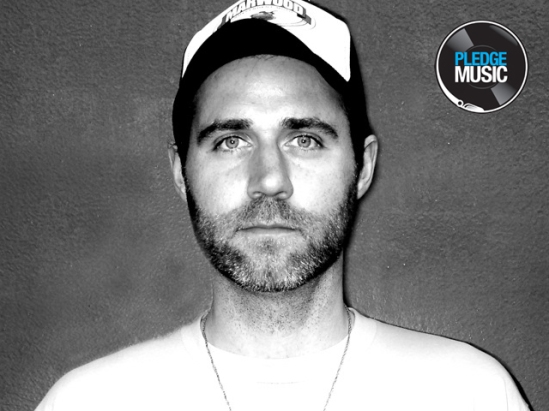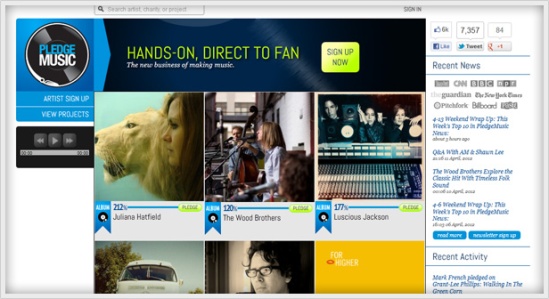Industry Evolution: The Changing Face of Music Consumption – Interview with Benji Rogers, founder of PledgeMusic
The music industry has gone through a series of significant changes with respect to how music is sold, consumed and shared. While many of us were just becoming cognizant of music’s appeal before MP3s existed, the structure of the industry was, in a lot of ways, fundamentally different than it is today. We spent many hours wandering the record store isles to find the newest Offspring album, or got a hold of our favourite zine to see what’s new (as an alternative to Much Music). Of course, indie labels existed, but not on the scale they do today with many thousands popping up all around the world.
Getting your demo in the hands of major labels is no longer a major concern for indie musicians , as alternatives have blossomed with technological progress. The DIY approach to music has become a dominant force in the industry, not only with respect to recording technology and self-recording demos, but also the PR and distribution side of the business. While indie labels have exploded in number over the last decade, many musicians are still vying for doing business their way (particularly in the initial breakout stage). “Distribution” has an entirely new meaning all together now than it did 15 years ago. For artists, it’s not so much about getting your album into people’s hands as much as it’s about getting your music into their ears – one way or another. Most indie artists stream their albums online, making ease of access to the end product that much easier.
With artists taking a more hands-on approach to the business side of things, there’s one piece of the puzzle that still needs to be figured out. The Nielsen study released at SXSW this year included a survey of 4,000 music consumers and looked at the degree to which different types of consumers connect with artists through exclusive content. It was found that there could be potential incremental revenue of $450 million to $2.6 billion if artists, managers and labels offered a better set of products and experiences to fans. Essentially, fans want more and they desire unique experiences from the artist, not just the final product of an album.
I spoke with Benji Rogers, founder and CEO of PledgeMusic at Canadian Music Week in March of this year. PledgeMusic is a direct-to-fan version of crowdfunding (not unlike Indiegogo or Kickstarter, but unique in it’s own way) that can engage musicians, fans, and the industry all at once. The company has worked with Canadian artists such as The Balconies (Ottawa/Toronto) and Ben Caplan (Halifax) to give their fans a different experience with their music while raising funds for their respective projects (each of whom have surpassed their goal). With PledgeMusic’s Canadian debut at Canadian Music Week, Benji had a lot to say about how his platform works, and what it can offer Canadian musicians as technology evolves and a changing dynamic in the way music consumption occurs. Read the interview below.
Interview with Benji Rogers, CEO of PledgeMusic
Can you describe how PledgeMusic works as a concept, and how it can benefit indie musicians?
Well, the way artists used to put music out was either make it themselves and try to sell it to people at shows, or, try and get a record deal and then sell your album through stores. What crowdfunding has done is provide artists with an alternative method of raising money. PledgeMusic is a version of crowdfunding. Crowdfunding is when an artists asks for “x” amount of money, and once they achieve their funding goal they go make an album. That’s all well and good, but what I saw was artists had to publicly show how much money they raised, and a lot of people weren’t comfortable with that.
So what we did is we spun it. Instead of saying “give us this money and then we’ll go do”, we said “pledge here to be a part of the making of the album”, and from day one pledgers will get access to video blogs, demos, early takes, all the crazy shit that goes on before things are done. By the end of the campaign, we’ll deliver the record to you and part of the profits can be given to a charity of your choice. So a local band would approach our team, either in person or by email, and sign up on the platform. One of us will look at the project and say whether they are trying to raise to much or too little, and then look at how much they need to get their project where they need it to be. We want to make the maximum number of campaigns to succeed.
When you start an internet business, most of the time the goal is just to get as many users as possible. Many crowdfunding platforms were set up to launch millions of campaigns. We weren’t. We were meant to launch the right campaigns, and see those campaigns through without just being a “buy” button on the internet. There are millions of those and they don’t work well at all. So, if the artists embraces the concept of allowing pledgers to be a part of the making of the album, or the tour, or whatever it is – the fans can be a part of the process as it progresses. Artists can get into this horrible trend of “pre-order my album, buy my album, and have you bought my album”? When you get to have you bought my album then you have a problem.
What our hybrid of crowdfunding and direct-to-fan has done is opened up a way to say “we’re going to do something cool, and you can be a part of the story”. That can be through an iPhone app, a video blog, tracking what’s happening in the studio, giving the
updates that fans want. You’re allowing the fans buy the journey and not just the end result. That’s a really big change in the way people are thinking about music. Looking at Neilson’s soundscan data, there’s a half-billion to 2 billion dollars a year in the US alone on the table that fans could buy into. Not buy things, but buy into – a very important distinction. Being a part of that journey for 30 days, 60 days, 5 years, fans can be along for the ride.
Crowdfunding also showed the financial target, we don’t. What I didn’t want to do was have the amount of money to taint the perception of the music. If you’re in a band and your target is $30,000 and you’re struggling to make $3,000 then people might start to think your band sucks. You may also just have a shitty manager who tried to get you to launch something that just wasn’t going to work. So if you hide the financials, then it doesn’t matter whether you’re the Headstones or a no-name indie band that no one knows – it’s all about the quality of the project. Your challenge is to make your release as compelling and interesting as possible, on top of making a great album.
What do you think the Canadian music industry can gain from PledgeMusic coming here? Is there anything in particular that you are excited about expanding into Canada?
Absolutely. People in the Canadian music scene help each other (although many will deny it). A lot of bands in New York will step over each other in the sidewalk to get where they want to go. In Canada, it’s more of a community. And the government embraces it too, which is so fundamental in giving these artists a leg-up because you have that support mechanism. Secondly, because everything is so spread out, each region has its own scene and they will support each other because they’re in it together. What you end up with is a sense of community and ownership of those artists. All we’re doing is giving those fans a chance to be part of the larger story. Canadian artists are always trying to break out over the border and play SXSW, but what they should be doing is coming to their fans and asking them to pledge towards their trip to SXSW. “Take the fans along the journey and we’ll bring you back a live album.” Then your local community of fans will get to experience the journey, you’ll meet new fans there and bring back something special. So artists can leave without leaving. Fans are desperate for this kind of connection.
The label structures and the distribution structures are also different here, which means there is huge opportunity. What we want to do as a company is hire someone to cover this territory and also engage with the government to ensure what we do is applicable. It should be a piece of it that Canadian artists own, and they should be a part of it. I’ve seen some phenomenal music out here, and we as a company have been embraced. We were invited into this country and now our job is to deliver.
You mentioned the Neilsen Study that was presented at SXSW recently. Are there any other revelations from that study that really blew you away?
They divided people so that 40% were fans, and 60% were consumers. The 40% of fans we’re talking about are aficionado fans, real music geeks who are big into digital music, as well as big box fans that go to the music store to buy records. Those 40% of people, the aficionado fans, buy over 75% of all recorded music. That’s a huge chunk. So why are we sending them to Spotify? Not to say anything against those services, but it’s a very relevant point. What was amazing was that consumers, the other 60%, wanted to be part of pledge campaigns and spend more money. However, they didn’t know these campaigns existed. So it’s up to the industry to explain that you don’t just need to buy music in stores or stream it online. People can engage with the artists in new ways, and they want to.
So, if I’m a hardcore Canadian music fan and I spend an average of over $65 every transaction involved with purchasing music, you’re telling me my only options are to go to music stores or iTunes to buy a band’s latest album? I don’t want the usual stuff. If a band doesn’t offer those extra things, I can’t get them. The reason why this opportunity is so great is because artists just need to provide fans the opportunity to come along, and they will join in. There’s a bunch of “consumers” out there that would become fans if they were able to have access to it.
The Neilsen data basically confirmed what I had been thinking for years. It matched our internal metrics, even though it was risky to let them use our data I knew our fans were having a great time (and they were).
Do you see crowdfunding and direct-to-fan platforms like PledgeMusic as the inevitable next step for the music industry – not only in the US, but globally? Are these platforms compatible with traditional thinking within the institutions of the music industry?
Crowdfunding will have a limited shelf life if it doesn’t address certain fundamental things. We’re already starting to see “donor fatigue” occur, where so many people are giving money and nothing is arriving. One of the things we do at Pledge, and one of the reasons I separate us from crowdfunding is because crowdfunding is basically “give me money, I’ll go make”. Direct-to-consumer is “here’s some shit to buy on a website”. Direct-to-fan/crowdfunding is the journey I’ve been talking about. The reason I don’t classify us as crowdfunding per se is because we don’t do that. There is a funding element to what we do, but it’s not the same.
The industry can’t really work with crowdfunding because it’s all about asking for funding, then making the product. What we’ve done is make a hybrid, we have the “be a part of it” factor. The label can be a part of that, engaging with fans in different ways. Labels are full of creative and passionate people who often aren’t given the tools they need to sell albums the way they want. Instead of doing a 6-week campaign, why not do a 5-month campaign? The label can become part of the conversation. Because we have pieces like soundscan that are already built-in, we are a way that the fans can be a part of the process and the label as well.
I designed a tool, from inception, that the industry can use. My parents were managers, and so I thought, “what do managers need”? They need analytics, they need data, and they need money and fans. If we are to be what I want us to be, which is the iTunes of the pledging experience, then the manager and label have the control because they are able to access their customers directly and they can deliver it.
Do you worry about donor fatigue affecting your platform, or is it more resilient to those effects?
Let me say this about donor fatigue. You can only experience donor fatigue if you are asking for donations. If you create a campaign and don’t offer a great experience, they might get campaign fatigue. However, if you offer a phenomenal journey, then that all changes. This relates to concerns for artists worried about running multiple campaigns, ie. how many times can you go back to the well before it is dry? It’s not that hard. You can do everything you need to do on a phone! The more you combine the artist with that fan experience the better. Think of it this way, if a band has a huge first album and then has to come up with number two and disappears for a year, what happens? They show up and expect people to open their wallets? You’ve changed as an artist without allowing fans to evolve with you. Pledge Music offers fans to help bridge that gap and be a part of it. What consumers will end up with is a physical manifestation of that journey in the end.



